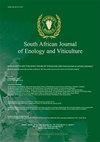葡萄无籽部位和种子生物活性成分和矿物质含量的测定
IF 1.1
4区 农林科学
Q4 FOOD SCIENCE & TECHNOLOGY
引用次数: 21
摘要
本研究对食用葡萄和酿酒葡萄的无核部分(果肉+果皮)和种子的酚类化合物、矿物质、总黄酮、总酚含量和抗氧化活性进行了测定。并对食用葡萄和酿酒葡萄种子油的总油、生育酚含量和脂肪酸组成进行了研究。葡萄果肉中总酚含量最高的是Trakya ilkeren (199.063mg/100 g),总黄酮和抗氧化活性较高的是Red Globe (6.810 mg/g, 90.948%)。葡萄种子抗氧化活性、总酚和总黄酮含量分别在86.688 ~ 90.974%、421.563 ~ 490.625 mg GAE/100 g和90.595 ~ 145.595 mg/g之间变化(p < 0.05)。一般来说,所有葡萄果肉和种子的主要酚类化合物是没食子酸、3,4-二羟基苯甲酸、(+)-儿茶素和1,2-二羟基苯。葡萄籽含油量在5.275 ~ 13.881%之间(p < 0.05)。葡萄籽油的主要脂肪酸是亚油酸、油酸和棕榈酸。与其他品种相比,Trakya ilkeren品种的种子油中含有丰富的生育酚。无籽部分和种子的主要矿物质为K、Ca、P、S、Mg。本文章由计算机程序翻译,如有差异,请以英文原文为准。
Determination of Bioactive Compounds and Mineral Contents of Seedless Parts and Seeds of Grapes
In this study, phenolic compounds, minerals, total flavonoids, total phenolic contents and antioxidant activities of the seedless parts (pulp+skin) and seeds of table and wine grapes were determined. Also, the total oil, tocopherol contents and fatty acid composition of seed oils of table and wine grapes were investigated. The highest total phenolic content of the grape pulp was found in Trakya ilkeren (199.063mg/100 g), while total flavonoid and antioxidant activity of the pulp was determined at a high level in Red Globe (6.810 mg/g, 90.948%). Antioxidant activity, and the total phenolic and flavonoid contents of grape seeds varied between 86.688 and 90.974%, 421.563 and 490.625 mg GAE/100 g, and 90.595 and 145.595 mg/g respectively (p < 0.05). Generally, the main phenolic compounds of all grape pulps and seeds were gallic acid, 3,4- dihydroxybenzoic acid, (+)-catechin and 1,2-dihydroxybenzene. In addition, the oil contents of grape seeds ranged from 5.275 (Cavus) to 13.881% (Cinarli karasi) (p < 0.05). The major fatty acids of grape seed oils were linoleic, oleic and palmitic acid. The seed oil of the Trakya ilkeren variety was rich in tocopherols in comparison with the other varieties. The major minerals of both the seedless parts and the seeds were determined as K, Ca, P, S, Mg.
求助全文
通过发布文献求助,成功后即可免费获取论文全文。
去求助
来源期刊
CiteScore
2.50
自引率
7.70%
发文量
1
审稿时长
>36 weeks
期刊介绍:
The South African Journal of Enology and Viticulture (SAJEV) publishes full-length original Research Papers, Research Notes and Review Papers on all subjects related to enology and viticulture. The SAJEV does not accept articles published in, or submitted to, other journals.

 求助内容:
求助内容: 应助结果提醒方式:
应助结果提醒方式:


